Spoon bird: agile birds in wetlands
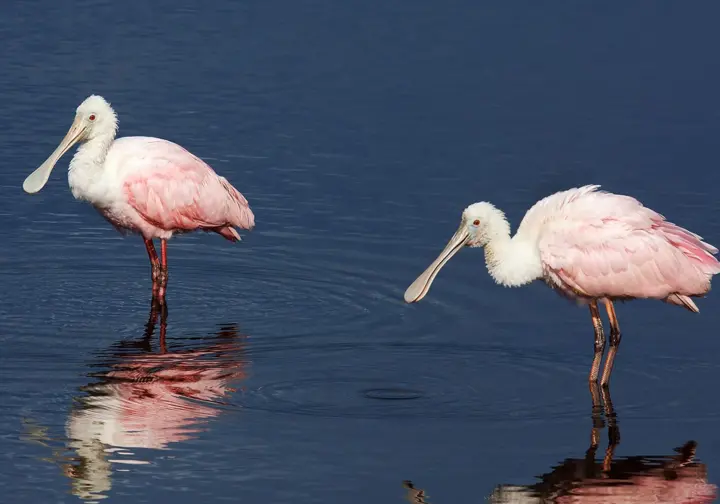
Birds are considered one of the most impressive creatures with their unique skills and abilities. Birds mimic many of the qualities of humans, such as the ability to fly and overcome difficulties. Among these birds, a distinctive species called the "spoon boy: the agile wetlands birds". They are a species of birds with a unique shape and exceptional abilities that distinguish them from the rest of the birds.
Show key points
- Spoonbills are a unique and graceful group of birds found in wetland habitats across various parts of the world, including Africa, Asia, Australia, and the Americas.
- With their distinctive spoon-shaped beaks, vibrant plumage, and elegant flight, spoonbills exhibit both beauty and specialized hunting abilities.
- These birds primarily feed on small aquatic animals like fish and crustaceans, using their specialized beaks to sweep through shallow waters.
- ADVERTISEMENT
- Spoonbills are highly social creatures that live and breed in colonies, constructing elaborate nests from twigs and aquatic plants.
- Migration patterns allow spoonbills to adapt to climate changes, moving to warmer wetlands during harsh winters and returning in spring.
- Despite their resilience, spoonbills face threats such as habitat loss, pollution, poaching, and climate change that endanger their survival.
- Conservation efforts are vital to ensure the continuation of this fascinating species, highlighting the need to protect their natural wetland environments.
1. Geographical distribution of the spoon bird: agile birds in wetlands.

Spoon species vary in their geographical distribution, with different species being found in specific regions around the world. We will consider six species of spoon bird:
White spoon bird (Platalea leucorodia): It is the most widely distributed spoon bird. Distributed in northeast Africa and large bird areas in Europe and Asia. Adult and young parrots are white in color and have black beaks and paws on the tips of their wings. They breed in reed beds.
Recommend
Black-faced spoon bird (Platalea minor): It is distributed in East Asia including mainland China, Hong Kong, Taiwan, South Korea and Japan.
African spoon bird (Platalea alba): subspecies in Africa and Madagascar. It resembles a white spoon bird, but its face is pink and its beak lighter in color. They eat mainly insects and other small crustaceans and build their nests in trees, swamps or rocks.
Royal spoon bird (Platalea regia): Very common in southeastern Australia, but is also found in small numbers in New Zealand, New Guinea, Indonesia and the Pacific Islands.
Yellow-billed spoonbill (Platalea flavipes): It is mainly common in southeastern Australia, and some people get lost and end up in New Zealand, Lord Howe Island and Norfolk Island.
Pink spoon bird (Platalea ajaja or Ajaia ajaja): It is a pink bird. Distributed in South America, the Caribbean, Texas, Louisiana and Colorado in the United States.
2. Appearance and behavior Spoon bird: the unique symbol of strength and sensuality.
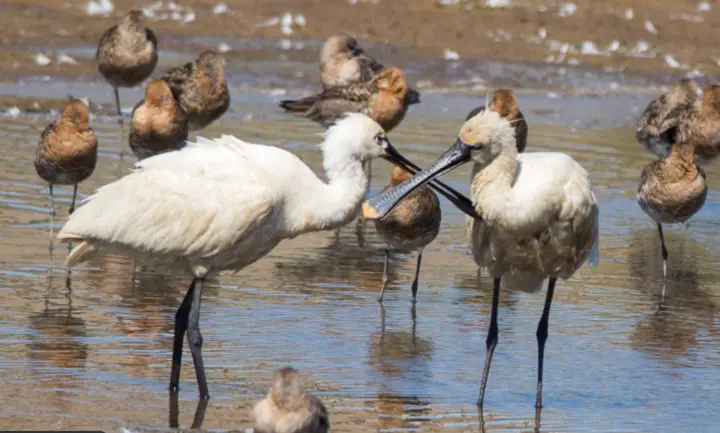
One of the most beautiful birds in the natural world, the spoon is distinguished by its unique appearance and exciting behavior. Found in wetlands around the world, these birds are distinguished by their beautiful shape that attracts attention and impresses.
The appearance of the spoon is characterized by its slim texture and medium size, with a body length of about 50 centimeters. It is characterized by its elegant and colorful plumage ranging from white, grey and black, with touches of bright green and blue on its wings and back. But the notable feature of their appearance is the long, spoon-like beak, which is intended to be used in search of food.
In addition to its beautiful appearance, the behavior of the spoonful is characterized by sensuality and intelligence. These birds are considered accomplished hunters, using their long, pointed beak to catch fish, snails and other small animals in shallow waters. She traps her prey by spreading her wings and shooting herself at herself, then uses the long beak to grab prey at breakneck speed.
Moreover, the spoon is a social bird, living and breeding in large groups called trips. Flight members align their movements and sounds, adding beauty to their harmonious flight scene in the sky.
3. Biological habits of the spoon bird: the unique bird in the bird world.
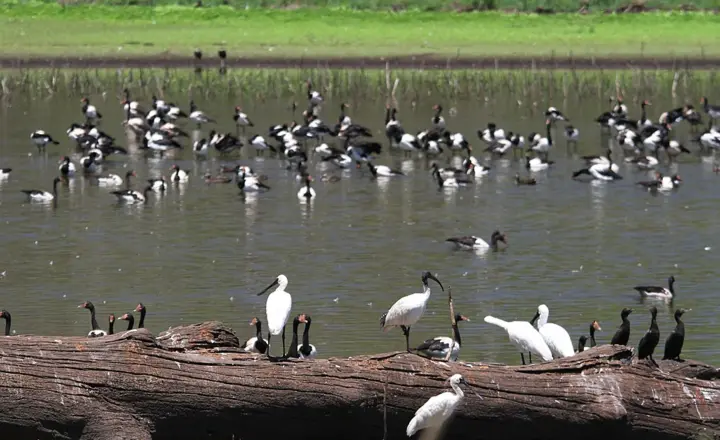
The biological habits of the spoon bird are distinguished by versatility and remarkable adaptation to their humid environment. These birds live in swamps, wetlands and calm rivers in different regions around the world. Below we will look at some of her interesting biological habits:
1. Nest construction: The spoon bird is characterized by building a complex and durable nest in aquatic trees or near water. The bird uses tree branches and aquatic plants to build its nest, and lays its eggs in it. Such a nest is considered a safe haven for chicks and helps protect them from enemies.
2. Food and nutrition: The spoon bird feeds mainly on small animals such as fish, crustaceans and insects. A long, curved spoon is used in its beak to capture prey from water or from aquatic soil. They are characterized by strong eyesight and effective digestive regulation to meet their nutritional needs.
3. Flight and movement: Spoon birds are birds with agile and amazing movement in the air. Its large, narrow wings and long tail are used to obtain enough thrust to fly. It features quiet and harmonious movements in flight, enabling it to hunt prey easily and quickly.
4. Reproduction and social interaction: The spoon is famous for its mass breeding in large groups. Birds display their attractive colors and perform characteristic sounds to attract the right partner. After building the nest and laying the eggs, the parents take part in caring for the chicks and feeding them until they grow up and are able to fly on their own.
5. Climatic presence and migration: The spoon bird has the ability to adapt to a variety of atmospheres. In some places where winters are harsh, they migrate to warmer areas to survive and avoid harsh conditions. Water routes are used as migration paths and they return to breeding grounds in the spring.
4. Breeding and feeding methods for spoon boys: their sophisticated strategies.
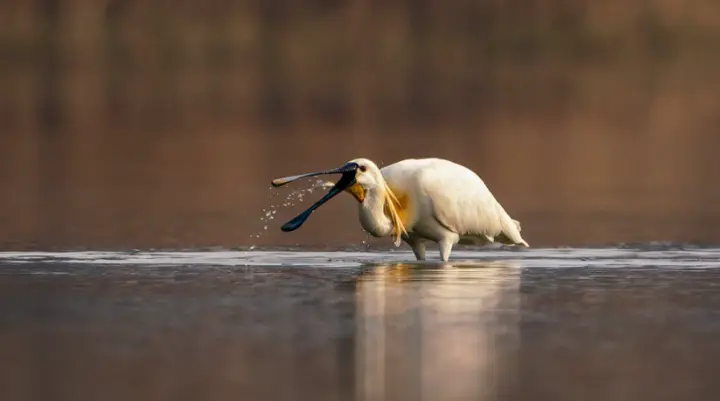
Breeding and feeding methods for the spoon bird:
First of all. Reproduction strategies:
The spoon bird has unique breeding methods that help it survive and sustain its offspring. Males and females build their nests in wet areas, such as lakes, rivers and swamps. The male decorates the nest with herbs and twigs to attract females. After mating, the couple collaborates in building the nest and preparing it to receive the eggs.
Secondly. Incubation and hatching:
The female usually lays two or three eggs in the spoon's nest. Research suggests that the incubation period lasts for 20 to 30 days. The couple is engaged in hatching eggs and providing protection for their young.
Thirdly. Fishing strategies:
The spoon bird uses various hunting strategies to obtain food. For example, they roam in stagnant water in search of fish, riding low branches to be able to see potential underwater prey. They can also wait silently and not move to suddenly catch their prey.
Fourthly. Nutrition and survival:
Abu Al-Malaqa faces challenges in maintaining its habitats and food sources in light of environmental changes. Water pollution and the degradation of wetlands are among the challenges to be faced. In addition, overfishing and habitat loss pose a major threat to the survival of this beautiful species. We therefore need to intensify efforts to protect and preserve the spoon and its habitats to ensure the continuity of this unique species in wetlands.
5. The challenges facing the spoon bird and their impact on the survival of this wonderful species.

Challenges facing the spoon bird:
First of all. Natural habitat degradation: The wetlands where the spoon bird lives suffer continuous degradation as a result of climate change and environmental pollution. Low water levels and pollution cause the natural habitats available to birds to shrink, affecting their ability to find and breed their food.
Secondly. Poaching: The spoon bird is considered a target for poachers because of the beauty of its plumage and unique shape. They are hunted illegally for use in the illegal pet trade or decoration.
Thirdly. Destruction of natural habitats: The habitat of Abu al-Malaqa is deliberately destroyed in favor of urbanization or agriculture. It removes and dries wetlands for human enterprise, resulting in the loss of their habitat and a decrease in the number of successful birds living in them.
Fourthly. Climate change: Spoonbills are highly affected by climate change, affecting the availability of food resources and leading to a change in the timing and trajectory of their migration. Birds may lose their traditional habitat and have to look for other areas to settle.
Fifthly. Noise pollution: The spoon bird relies on voice communications to communicate, mate and warn of danger. Noise pollution from human activities, such as industrial facilities and traffic, affects their ability to communicate effectively and may lead to disconnection and dispersion of nests.
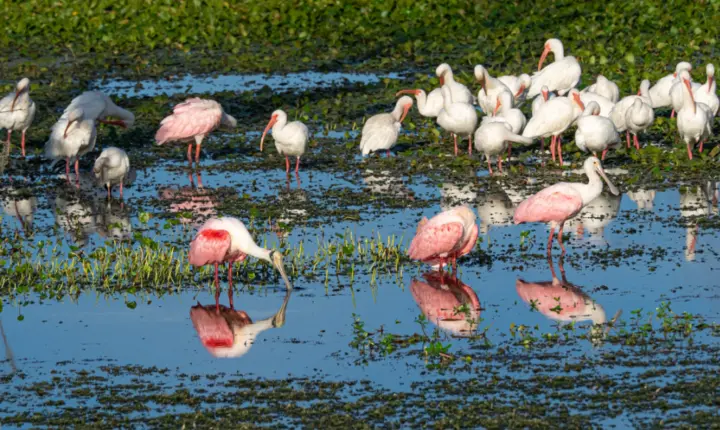
Eventually, we will have a deeper understanding of these agile wetland creatures and how they adapt to their challenging environments. We will recognise the importance of protecting and preserving the Spoon and its shared habitats, so that these magnificent birds will continue to fly in our skies for years to come.








